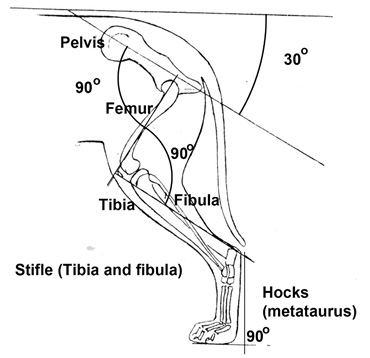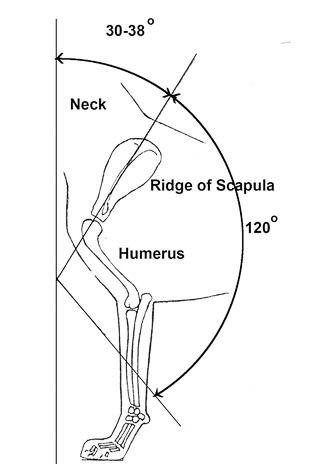Good Body Conformation

A good rear end powers the dog. Fortunately Apple Acres Odyssey Armani ROM is famous among sheltie people as having had and passing on a great rear. All of our dogs have good rears, but so do many shelties, so don’t look at a sheltie with a bad rear. According to the standard:
"The femur should be set into the pelvis at a right angle corresponding to the angle of the shoulder blade and upper arm. Stifle bones join the femur at about 90° and should be distinctly angled at the stifle joint."
The pelvis is set 30° from the horizontal line drawn from the back. The main thing to watch for here is having a hock that is perfectly perpendicular to the ground when the dog is standing properly (feet stacked not stretched out back or under the dog). The hocks are straight and parallel to each other. Rear toes should not point out or point in!

A good front is important as it is what takes the weight as the dog jumps on and off obstacles and when landing a jump. The chest should be broad and the front legs should not be spaced too close together. You should be able to putabout 3 fingers (depends on the size of your hand and the dog) in the space in an adult. This gives room for the heart, lungs and other organs. Also you want the front toes pointed forward not out or in. The sheltie standard talks a lot about 45° angles which are actually anatomically impossible for the dog (there are several articles on this but the standard has not been changed). However these angles should be around 30-38° and the withers should lay back towards the rear of the dog and should not be on the neck of the dog. The shoulder bone should not be vertical but should point back to the rear of the dog. The length of the upper arm should equal the length of the shoulder. This trait is very rare in shelties today, and most shelties will have an upper arm that is a little shorter. If a dog feels flat between the front legs and the neck then the dog has a flat front (insufficient post sternum). I can tell you as a breeder that a good front is very hard to get in a sheltie line that does not already have one and very easy to lose in a single breeding!! Many of us feel that a bad front is the most common fault seen in shelties today. We are fortunate to have had very good breeding stock to start with through the generosity of our breeder friends/mentors.
